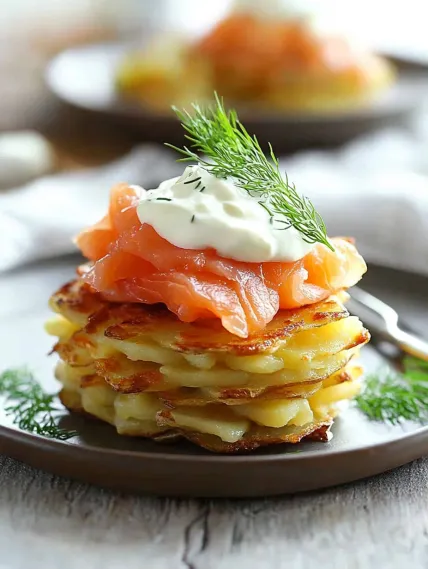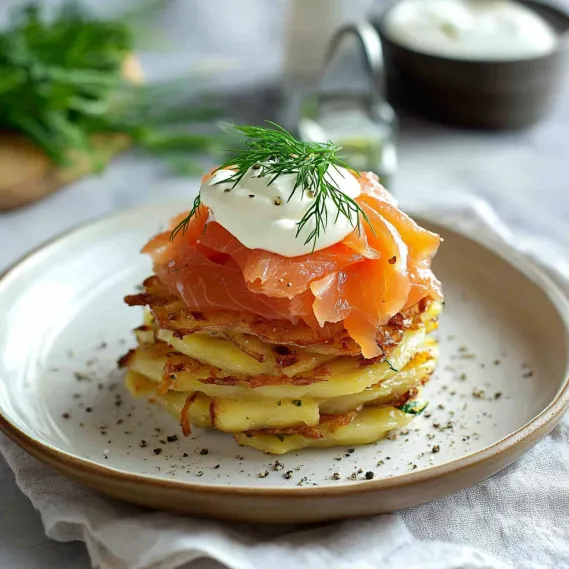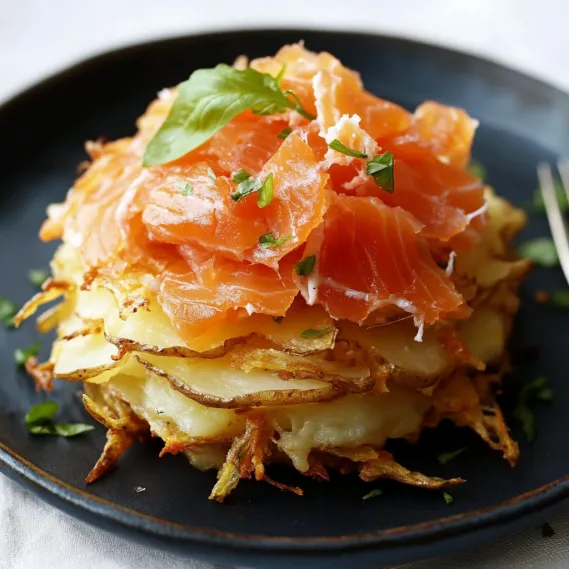 Pin it
Pin it
This indulgent breakfast brings together golden, crispy potato rostis layered with delicate smoked salmon and topped with a dollop of cool, tangy sour cream. The contrast between the hot, crunchy potato pancakes and the silky, rich salmon creates a perfect harmony of textures and flavors. Despite its impressive appearance that suggests restaurant-quality sophistication, this dish requires minimal ingredients and straightforward techniques. Best of all, at just 370 calories per serving, you can enjoy this luxurious breakfast without the usual calorie guilt associated with such an elegant meal.
The first time I served these stacks for a weekend brunch, my guests assumed I'd spent the morning slaving away in the kitchen. Little did they know I'd made the rostis the night before and simply reheated them while setting the table. When I revealed my secret, three different friends requested the recipe before leaving. Now it's my signature dish for impressing visitors without exhausting myself in the process.
Essential Ingredients and Selection Tips
- Potatoes: Choose starchy varieties like Russets, Dutch Creams, or King Edwards. Their high starch content creates the perfect fluffy interior and crispy exterior.
- Smoked Salmon: Look for deep pink slices with a smooth, silky texture. Cold-smoked salmon offers the best delicate flavor for this dish.
- Sour Cream: Full-fat provides the richest flavor, but light varieties work well too if you're watching calories.
- Butter and Olive Oil: The combination creates the perfect fat for frying, with butter adding flavor and oil preventing burning.
- Fresh Dill: Optional but highly recommended for its classic pairing with salmon. The bright, grassy notes cut through the richness.
I've found that the quality of your potatoes makes a remarkable difference in the final texture of the rostis. The starchier the potato, the crispier the outside and fluffier the inside will be. For Australians, Sebago potatoes (the dirt-covered ones) from the supermarket work perfectly.
Detailed Cooking Instructions
- Step 1: Prepare The Potatoes
- Microwave whole, unpeeled potatoes for 1½ minutes, turn them over, then microwave for another 2 minutes. They should be partially cooked but still raw in the center. Hold with a dish towel and peel while warm, then coarsely grate them into a bowl. Mix with melted butter, salt, and pepper until well combined.
- Step 2: Form Perfect Rosti Patties
- Heat olive oil in a large frying pan over medium-high heat. Measure ¼ cup of potato mixture and lightly pack it into the measuring cup, then place it in the hot pan. Gently flatten to about ⅓-inch thickness with a spatula. Repeat with remaining mixture, being careful not to overcrowd the pan.
- Step 3: Achieve Golden Crispiness
- Cook each rosti until deep golden brown and crispy on the first side, about 1½-2 minutes. Carefully flip with a spatula and cook for the same time on the second side. The edges should be lacy and crisp, while the center remains tender. Transfer to a paper towel-lined plate.
- Step 4: Assemble Your Impressive Stack
- Place three rostis on each serving plate, slightly overlapping or stacked directly on top of each other. Drape thin slices of smoked salmon over the top, allowing it to fold and ripple naturally for the most elegant presentation. Finish with a generous dollop of sour cream.
- Step 5: Add The Finishing Touch
- Garnish with fresh dill sprigs and a twist of black pepper. Serve immediately while the rostis are hot and crispy, with a lemon wedge on the side for brightening the flavors of the salmon and sour cream before each bite.
 Pin it
Pin it
The first time I made this recipe, I skipped partially cooking the potatoes, thinking it would save time. The result was soggy, pale rostis that fell apart during cooking. Now I never skip that brief microwaving step - it's the secret to achieving that perfect crispy exterior that holds together beautifully.
The Secret To Perfect Wok Technique
High heat is essential for authentic fried rice. My grandmother taught me to heat the wok until smoking before adding oil. Keep ingredients moving constantly to achieve that elusive "wok hei" flavor. Never overcrowd the pan—cook in batches instead. This technique transformed my fried rice into restaurant-quality perfection.
 Pin it
Pin it
Making The Most Of Leftovers
This dish excels at transforming leftovers into something exciting. I've used roast chicken, holiday ham, and even Thanksgiving turkey with great success. Cut meat into uniform pieces that distribute evenly throughout. Leftover grilled steak adds incredible depth with its smoky edges. Even roasted vegetables bring delightful caramelized sweetness.
Balancing Flavors And Textures
Special fried rice succeeds through balanced components. Char siu provides richness, prawns add sweetness, eggs contribute silkiness, while vegetables offer freshness. The sequence matters—aromatics first build flavor, eggs midway remain distinct, vegetables maintain crispness. Adding spring onions last preserves their brightness for that authentic restaurant finish.
Customization For Dietary Needs
This dish adapts easily to dietary restrictions. For vegetarians, I omit meat, double eggs and add extra vegetables. Low-carb diners enjoy my cauliflower rice version that carries flavors beautifully. For gluten-sensitive guests, tamari replaces soy sauce while ensuring chicken powder is certified gluten-free. Everyone enjoys this beloved dish regardless of restrictions.
Perfect Potato Selection
The science behind the perfect rosti comes down to starch content. High-starch potatoes create that magical contrast between crispy exterior and fluffy interior. I've experimented with various potatoes and found that Russets (in the US) or Sebago (in Australia) consistently deliver the best results. These varieties break down slightly during cooking, creating pockets of steam that result in that fluffy interior, while their starch content caramelizes beautifully on the outside. If you can only find all-purpose potatoes, add a teaspoon of cornstarch to the grated mixture to boost the crispiness factor.
Elegant Variations For Different Occasions
While the classic version pairs perfectly with smoked salmon, I've created several variations that work beautifully with the same potato base. For a festive holiday brunch, I top the rostis with crème fraîche and caviar for the ultimate indulgence. For casual lunches, I replace the salmon with sliced avocado and poached eggs, allowing the velvety yolk to create a natural sauce. For dinner parties, I make miniature rostis topped with a horseradish cream and rare roast beef for sophisticated finger food. The versatility of the potato base makes this recipe a true kitchen workhorse.
Make-Ahead Entertaining Strategy
The make-ahead capability transforms this seemingly complex dish into a practical option for entertaining. My strategy for hosting brunch: prepare and cook all rostis the day before, store them separated by parchment paper in an airtight container in the refrigerator, then reheat on a baking sheet in a hot oven just before serving. This approach allows me to enjoy my morning coffee with guests instead of standing over a hot stove. For an even more impressive spread, I set up a build-your-own stack station with the hot rostis, smoked salmon, various toppings like capers and red onion, and several sauce options including sour cream, crème fraîche, and dill sauce.
 Pin it
Pin it
These Smoked Salmon Potato Rosti Stacks have become my signature dish for special breakfasts and brunches. There's something magical about the combination of hot, crispy potatoes and cool, silky salmon that feels indulgent yet surprisingly light. Whether you're treating yourself to a weekend breakfast upgrade or impressing guests with your culinary skills, this dish delivers maximum impact with minimal effort—truly the best kind of recipe to have in your repertoire.
Frequently Asked Questions
- → Can I make the potato rösti ahead of time?
- Yes! The rösti can be made a day ahead and stored in the refrigerator. To reheat, place them in a hot oven (200°C/390°F) for about 15 minutes until they become dark golden brown and crispy again. This makes them perfect for entertaining as you can do most of the preparation in advance.
- → What type of potatoes work best for rösti?
- Starchy potatoes yield the best results as they break down when cooked, creating a fluffy interior and crispy exterior. Russet potatoes (common in the US) are ideal, but Dutch creams, King Edwards, or red delights also work well. All-purpose potatoes like Sebago (popular in Australia) or Yukon Gold will still make good rösti, though slightly less fluffy.
- → Can I use hot smoked salmon instead of cold smoked salmon?
- Absolutely! While traditional cold smoked salmon (lox) is most commonly used in this recipe, hot smoked salmon makes a delicious alternative with a more substantial texture and smokier flavor. You could also use gravlax or even leftover cooked salmon if you prefer.
- → What can I substitute for sour cream?
- Greek yogurt makes an excellent substitute for sour cream, offering a similar tanginess with less fat. Crème fraîche works beautifully for a richer option. For dairy-free alternatives, try a dollop of cashew cream or coconut yogurt, though these will impart a slightly different flavor profile.
- → Why do you partially cook the potatoes first?
- Partially cooking the potatoes before grating helps them bind together better when making the rösti. It also significantly reduces the cooking time needed in the pan, ensuring the rösti cooks evenly with a perfect texture - crispy on the outside while remaining tender inside. Be careful not to overcook them initially; they should still be firm in the center.
- → What can I serve with this dish to make it a more substantial meal?
- To make this a more substantial brunch, consider adding a poached or fried egg on top, which creates a lovely sauce when the yolk breaks. A side of steamed asparagus or a simple green salad dressed with lemon vinaigrette complements the flavors beautifully. For a more decadent option, add some capers or a small dollop of caviar on top of the salmon.
